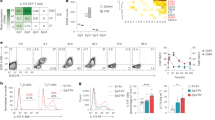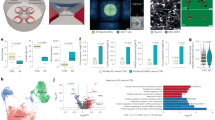Abstract
Controlling CD4+ immune cell infiltration of the brain is a leading aim in designing therapeutic strategies for a range of neuropathological disorders such as multiple sclerosis, Alzheimer’s disease, and depression. CD4+ T cells are a highly heterogeneous and reprogrammable family, which includes various distinctive cell types such as Th17, Th1, and Treg cells. Interestingly Th17 and Treg cells share a related transcriptomic profile, where the TGFβ–SMADS pathway plays a fundamental role in regulating the differentiation of both of these cell types. However, Th17 could be highly pathogenic and was shown to promote inflammation in various neuropathological disorders. Conversely, Treg is anti-inflammatory and is known to inhibit Th17. It could be noticed that Th17 frequencies of infiltration of the blood–brain barrier in various neurological disorders are significantly upregulated. However, Treg infiltration numbers are significantly low. The reasons behind these contradicting observations are still unknown. In this perspective, we propose that the difference in the T-cell receptor repertoire diversity, diapedesis pathways, chemokine expression, and mechanical properties of these two cell types could be contributing to answering this intriguing question.



Similar content being viewed by others
References
Abbas A, Lichtman A, Pillai S (2018) Cellular and molecular immunology 9th edition. Elsevier
Amoriello R, Greiff V, Aldinucci A, Bonechi E, Carnasciali A, Peruzzi B et al (2020) The TCR repertoire reconstitution in multiple sclerosis: comparing one-shot and continuous immunosuppressive therapies. Front Immunol [Internet]. 2020 Apr 9;11:559. Available from: https://www.frontiersin.org/article/https://doi.org/10.3389/fimmu.2020.00559/full
Balasa R, Barcutean L, Mosora O, Manu D (2021) Reviewing the significance of blood–brain barrier disruption in multiple sclerosis pathology and treatment. Int J Mol Sci [Internet]. 2021 Aug 4;22(16):8370. Available from: https://www.mdpi.com/1422-0067/22/16/8370
Basu R, Hatton RD, Weaver CT (2013) The Th17 family: flexibility follows function. Immunol Rev [Internet]. 2013 Mar;252(1):89–103. Available from: https://doi.org/10.1111/imr.12035
Basu R, O’Quinn DB, Silberger DJ, Schoeb TR, Fouser L, Ouyang W et al (2012) Th22 Cells are an important source of IL-22 for host protection against enteropathogenic bacteria. Immunity 37(6):1061–1075
Beurel E, Lowell JA (2018) Th17 cells in depression. Brain Behav Immun [Internet]. 2018 Mar;69:28–34. Available from: https://linkinghub.elsevier.com/retrieve/pii/S0889159117303896
Bhaumik S, Basu R (2017) Cellular and molecular dynamics of Th17 differentiation and its developmental plasticity in the intestinal immune response. Front Immunol [Internet]. 2017 Mar 31;8(254). Available from: https://doi.org/10.3389/fimmu.2017.00254/full
Crome SQ, Clive B, Wang AY, Kang CY, Chow V, Yu J et al (2010) Inflammatory effects of ex vivo human Th17 cells are suppressed by regulatory T cells. J Immunol 185(6):3199–3208
Dos PGR, Sato DK, Becker J, Fujihara K (2016) Th17 Cells pathways in multiple sclerosis and neuromyelitis optica spectrum disorders: pathophysiological and therapeutic implications. Mediators Inflamm 2016:1–11
Dusi S, Angiari S, Pietronigro EC, Lopez N, Angelini G, Zenaro E et al (2019) LFA-1 Controls Th1 and Th17 motility behavior in the inflamed central nervous system. Front Immunol [Internet]. 2019 Oct 18;10. Available from: https://www.frontiersin.org/article/https://doi.org/10.3389/fimmu.2019.02436/full
Evans-Marin HL, Cao AT, Yao S, Chen F, He C, Liu H et al (2015) Unexpected regulatory role of CCR9 in regulatory T cell development. Sun J Editor. PLoS One 10(7):e0134100
Jadidi-Niaragh F, Mirshafiey A (2011) Th17 Cell, the new player of neuroinflammatory process in multiple sclerosis. Scand J Immunol 74(1):1–13
Jankovic D, Kugler DG, Sher A (2010) IL-10 production by CD4+ effector T cells: a mechanism for self-regulation. Mucosal Immunol 3(3):239–246
Jiang X, Wang S yu, Zhou C, Wu J hua, Jiao Y hao, Lin LYA et al (2019) TCR repertoire analysis reveals effector memory T cells differentiation into Th17 cells in rheumatoid arthritis. bioRxiv
Kim BS, Lu H, Ichiyama K, Chen X, Zhang YB, Mistry NA et al (2017) Generation of RORγt + antigen-specific T regulatory 17 cells from Foxp3 + precursors in autoimmunity. Cell Rep 21(1):195–207
Kubick N, Flournoy PCH, Enciu A-M, Manda G, Mickael M-E (2020) Drugs modulating CD4+ T cells blood–brain barrier interaction in Alzheimer’s disease. Pharmaceutics 12(9):880
Kubick N, Henckell Flournoy PC, Klimovich P, Manda G, Mickael M (2020) What has single‐cell RNA sequencing revealed about microglial neuroimmunology? Immunity, Inflamm Dis [Internet] 8(4):825–39. Available from: https://doi.org/10.1002/iid3.362
Liu JX, Cao X, Tang YC, Liu Y, Tang FR (2007) CCR7, CCR8, CCR9 and CCR10 in the mouse hippocampal CA1 area and the dentate gyrus during and after pilocarpine-induced status epilepticus. J Neurochem [Internet]. 2007 Feb;100(4):1072–88. Available from: https://doi.org/10.1111/j.1471-4159.2006.04272.x
Li Q, Laumonnier Y, Syrovets T, Simmet T (2013) Recruitment of CCR6-expressing Th17 cells by CCL20 secreted from plasmin-stimulated macrophages. Acta Biochim Biophys Sin (shanghai) 45(7):593–600
Lopes Pinheiro MA, Kamermans A, Garcia-Vallejo JJ, van Het Hof B, Wierts L, O’Toole T et al (2016) Internalization and presentation of myelin antigens by the brain endothelium guides antigen-specific T cell migration. Elife [Internet]. 2016 Jun 23;5. Available from: https://elifesciences.org/articles/13149
Mickael M, Edwar K (2012) Modelling Baroreceptors Function (Doctoral dissertation, Durham University).
Mickael M-E, Basu R, Bhaumik S (2020) Retinoid-related orphan receptor RORγt in CD4+ T cell mediated intestinal homeostasis and inflammation. Am J Pathol. 02(1)
Muller WA (2016) Transendothelial migration: unifying principles from the endothelial perspective. Immunol Rev 273(1):61–75
Moser T, Akgün K, Proschmann U, Sellner J, Ziemssen T (2020) The role of TH17 cells in multiple sclerosis: therapeutic implications. Autoimmun Rev [Internet]. 2020 Oct;19(10):102647. Available from: https://linkinghub.elsevier.com/retrieve/pii/S1568997220302184
Muranski P, Restifo NP (2013) Essentials of Th17 cell commitment and plasticity. Vol. 121, Blood. American Society of Hematology p. 2402–2414
Mickael ME, Bhaumik S, Chakraborti A, Umfress AA, van Groen T, Macaluso M et al (2022) RORγt-Expressing pathogenic CD4+ T cells cause brain inflammation during chronic colitis. J Immunol [Internet]. 2022 Apr 15 [cited 2021 Sep 9];208(8):2054–66. Available from: https://journals.aai.org/jimmunol/article/208/8/2054/234759/ROR-t-Expressing-Pathogenic-CD4-T-Cells-Cause
Mickael ME, Kubick N, Klimovich P, Flournoy PH, Bieńkowska I, Sacharczuk M (2021) Paracellular and transcellular leukocytes diapedesis are divergent but interconnected evolutionary events. Genes (Basel) [Internet]. 2021 Sep 22 [cited 2021 Jan 30];12(2):1–18. Available from: https://doi.org/10.1101/2020.09.21.307066
Muller WA (2011) Mechanisms of leukocyte transendothelial migration. Annu Rev Pathol Mech Dis [Internet]. 2011 Feb 28;6(1):323–44. Available from: https://doi.org/10.1146/annurev-pathol-011110-130224
Schneider-Hohendorf T, Stenner M-P, Weidenfeller C, Zozulya AL, Simon OJ, Schwab N et al (2010) Regulatory T cells exhibit enhanced migratory characteristics, a feature impaired in patients with multiple sclerosis. Eur J Immunol [Internet]. 2010 Dec;40(12):3581–90. Available from: https://doi.org/10.1002/eji.201040558
Shetty S, Weston CJ, Oo YH, Westerlund N, Stamataki Z, Youster J et al (2011) Common lymphatic endothelial and vascular endothelial receptor-1 mediates the transmigration of regulatory T cells across human hepatic sinusoidal endothelium. J Immunol 186(7):4147–4155
Voloshin A (2020) Migration of the 3T3 cell with a lamellipodium on various stiffness substrates—tensegrity model. Appl Sci [Internet]. 2020 Sep 23;10(19):6644. Available from: https://www.mdpi.com/2076-3417/10/19/6644
Wang C, Kang SG, HogenEsch H, Love PE, Kim CH (2010) Retinoic acid determines the precise tissue tropism of inflammatory Th17 cells in the intestine. J Immunol 184(10):5519–5526
Winger RC, Koblinski JE, Kanda T, Ransohoff RM, Muller WA (2019) Rapid remodeling of tight junctions during paracellular diapedesis in a human model of the blood–brain barrier. J Immunol [Internet]. 2014 Sep 1 [cited 2019 Feb 6];193(5):2427–37. Available from: http://www.ncbi.nlm.nih.gov/pubmed/25063869
Wimmer I, Tietz S, Nishihara H, Deutsch U, Sallusto F, Gosselet F et al (2019) PECAM-1 stabilizes blood-brain barrier integrity and favors paracellular T-cell diapedesis across the blood-brain barrier during neuroinflammation. Front Immunol [Internet]. 2019 Apr 5;10:711. Available from: https://doi.org/10.3389/fimmu.2019.00711/full
Zhang S (2021) The role of transforming growth factor β in T helper 17 differentiation [Internet]. Vol. 155, Immunology. Blackwell Publishing Ltd; 2018 [cited 2021 Jan 28]. p. 24–35. Available from: https://pubmed.ncbi.nlm.nih.gov/29682722/
Acknowledgements
The authors thank Prof. Macrious Abraham and Prof. Mariam Joachim for the fruitful discussions and guidance.
Author information
Authors and Affiliations
Corresponding authors
Ethics declarations
Conflict of interest
The authors declare no competing interests.
Additional information
Publisher's Note
Springer Nature remains neutral with regard to jurisdictional claims in published maps and institutional affiliations.
Rights and permissions
Springer Nature or its licensor (e.g. a society or other partner) holds exclusive rights to this article under a publishing agreement with the author(s) or other rightsholder(s); author self-archiving of the accepted manuscript version of this article is solely governed by the terms of such publishing agreement and applicable law.
About this article
Cite this article
Kubick, N., Lazarczyk, M., Strzałkowska, N. et al. Factors regulating the differences in frequency of infiltration of Th17 and Treg of the blood–brain barrier. Immunogenetics 75, 417–423 (2023). https://doi.org/10.1007/s00251-023-01310-y
Received:
Accepted:
Published:
Issue Date:
DOI: https://doi.org/10.1007/s00251-023-01310-y




